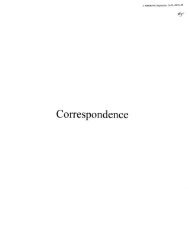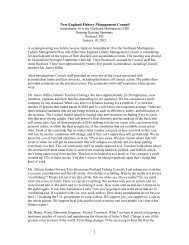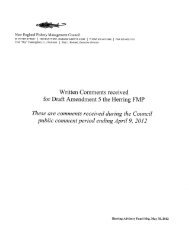Smooth Bottom Net Trawl Fishing Gear Effect on - New England ...
Smooth Bottom Net Trawl Fishing Gear Effect on - New England ...
Smooth Bottom Net Trawl Fishing Gear Effect on - New England ...
You also want an ePaper? Increase the reach of your titles
YUMPU automatically turns print PDFs into web optimized ePapers that Google loves.
NOAA/NMFS Unallied Science Project, Cooperative Agreement NA16FL2264 May 2005<br />
<str<strong>on</strong>g>Smooth</str<strong>on</strong>g> <str<strong>on</strong>g>Bottom</str<strong>on</strong>g> <str<strong>on</strong>g>Net</str<strong>on</strong>g> <str<strong>on</strong>g>Trawl</str<strong>on</strong>g> <str<strong>on</strong>g>Fishing</str<strong>on</strong>g> <str<strong>on</strong>g>Gear</str<strong>on</strong>g> <str<strong>on</strong>g>Effect</str<strong>on</strong>g> <strong>on</strong> the Seabed:<br />
Investigati<strong>on</strong> of Temporal and Cumulative <str<strong>on</strong>g>Effect</str<strong>on</strong>g>s BKAM/CR<br />
Little Tow<br />
Like Mud Hole the dominant size fracti<strong>on</strong> at Little Tow in July was medium sand (median phi of<br />
1.80 – 1.93) (Figure 3.2.3-2). The medium sand fracti<strong>on</strong> was greatest at the two northern<br />
Stati<strong>on</strong>s, LT1B and LT2B. Coarser fracti<strong>on</strong>s made up less than 3 percent of the samples. The<br />
fine sand fracti<strong>on</strong> was also similar to that at Mud Hole, and ranged from 9.0 to 19 percent. The<br />
fine sand fracti<strong>on</strong> was substantially higher at southern Stati<strong>on</strong>s LT3B and LT4B. The silt/clay<br />
fracti<strong>on</strong> in July was slightly greater and less variable than at Mud Hole, and ranged from 18.3 to<br />
24.8 percent. There was no detectable difference between the grain size distributi<strong>on</strong> of the<br />
c<strong>on</strong>trol versus the trawled lanes samples.<br />
Little Tow quartile deviati<strong>on</strong> results ranged from 0.42 phi to 0.68 phi, suggesting sediments at<br />
Little Tow are well to moderately well sorted. Both quartile deviati<strong>on</strong> and median phi values<br />
were lowest at the two northern Stati<strong>on</strong>s, suggesting that this porti<strong>on</strong> of the Little Tow possesses<br />
a finer and more homogeneous substrate than the southern porti<strong>on</strong> of the Site. This observati<strong>on</strong><br />
is supported by side-scan s<strong>on</strong>ar imagery, which shows that the northern porti<strong>on</strong> of Little Tow is<br />
less acoustically reflective than the southern porti<strong>on</strong>, and by site bathymetry, which shows that<br />
the northern porti<strong>on</strong> of the seabed at Little Tow is flatter and possesses fewer bathymetric<br />
irregularities than the southern porti<strong>on</strong>.<br />
3.2.3.2 Post-<str<strong>on</strong>g>Trawl</str<strong>on</strong>g> Site C<strong>on</strong>diti<strong>on</strong>s – October 9 and November 19, 2002<br />
At Mud Hole and Little Tow there were no discernible differences between the grain size<br />
distributi<strong>on</strong> for c<strong>on</strong>trol versus trawled lane samples following chr<strong>on</strong>ic trawling efforts from the<br />
end of July to the middle of November.<br />
Sediment particle size at Mud Hole was essentially unchanged from July 2002 to October 2002.<br />
One minor difference noted was slightly higher percentages of silt/clay at MH1B and MH2B in<br />
October than in July. Mud Hole sediment samples collected in November were similar to those<br />
collected in October. The dominant modal size was medium sand throughout the year. The<br />
silt/clay c<strong>on</strong>tent ranged from 13.6 to 21.9 percent. Additi<strong>on</strong>ally, the fine sand fracti<strong>on</strong> at Mud<br />
Hole stati<strong>on</strong>s decreased from July to October and from October to November.<br />
Temporal changes were more pr<strong>on</strong>ounced at Little Tow where there was a shift in modal size<br />
from medium sand to fine sand between July and October (see Figure 3.2.3-2). The fine and<br />
very fine sand fracti<strong>on</strong>s significantly increased at Little Tow from July to October, and<br />
significantly decreased from October to November. The November modal grain size reverted to<br />
medium sand except at LT1B. Coarse sands at Little Tow significantly increased from July to<br />
October and from October to November. The silt/clay c<strong>on</strong>tent of Little Tow sediments<br />
decreased from July 2002 to November 2002 in a roughly linear fashi<strong>on</strong>, with July, October and<br />
November means of 19.9, 17.3, and 10.3 percent, respectively. A possible explanati<strong>on</strong> for the<br />
pr<strong>on</strong>ounced changes at the more shallow stati<strong>on</strong>s of Little Tow is increased sediment mixing<br />
associated with seas<strong>on</strong>al or episodic differences in wave-induced bottom disturbances (see<br />
Figure 3.2.2.3-1 for a Time-Series record of wave heights in Mass Bay for 2002). As described<br />
previously, the November sampling event immediately followed a major northeasterly storm<br />
event. The average wave heights recorded for Mass. Bay during the 48 hours prior to the<br />
sampling events were 0.5 m (July), 0.8 m (October) and 1.9 m (November). Extensive seas<strong>on</strong>al<br />
37







